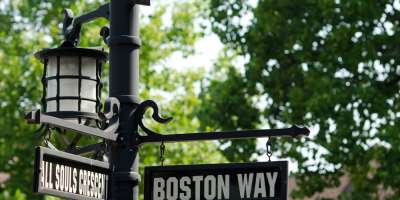6 Things You Didn't Know About Biltmore Village
By Cat Kessler

Street cars, fancy fast food and what's coming next
When George Vanderbilt and his team of architectural experts built the 250-room mansion and developed the (then) 120,000-acre estate that became Biltmore, they did so with a broad vision for the role the estate would play in the local community.
Beginning in the 1890s, architect Richard Morris Hunt and landscape designer Frederick Law Olmsted turned their sights to designing a mixed-use, English-style manor village at the entrance to Biltmore--similar to what viewers might see in the hit PBS series Downton Abbey. They planned for a community that would serve as an aesthetically pleasing welcome to visiting guests, but also one that would support the sizable workforce of the estate in all aspects of life. In fact, Hunt's original office, the original base camp for the estate's construction efforts, still stands in the center of the village--a testament to the little town that built the Biltmore.
See our complete guide to Biltmore Village!
Biltmore Village has more than a few stories to share, but here are a few you may not have heard:
-
One of the nation's first electric street railways opened in Asheville in 1889, and a few years later, a line was built to connect Biltmore Village with the Asheville Court House. The railway served many of the skilled workers who helped to build Biltmore Estate.
-
Architect Richard Morris Hunt--who is known for his work on the Metropolitan Museum of Art and many other private residences in addition to Biltmore -- designed and built only six churches in his career, including the All Souls Church (now Cathedral) that serves as the center of Biltmore Village. All of Hunt's other churches have since burned or been demolished, making All Souls the only surviving Hunt church. On the day the church was consecrated in 1896, the following was printed in the Asheville Citizen newspaper: "Mr. Vanderbilt's gilt is an edifice of original architecture, quaint in outward show of high pitched roofs of tile, but with a beautifully finished interior replete in ecclesiastical taste and requirement."
-
The designers of Biltmore Village left behind a legacy of a certain look, defined by stucco pebbledash and dark beams, which is echoed among the district's buildings. In 2001, this look took on a new shape with the opening of what has been termed "the world's fanciest McDonald's," which was designed to blend in with the village's aesthetic. The fast food restaurant features a grand piano and a stone fireplace, in addition to the famous McNuggets.
-
In 1926, the Biltmore-Oteen Bank opened in the village, and eventually moved into a beautiful Georgian Revival building alongside the railroad tracks. Like many establishments, the bank did not survive the Great Depression, but the building did and today houses the work of local craftsmen at the Southern Highland Craft Gallery.
-
Among a variety of established shops and galleries, a handful of new shops are popping up all the time. Among the shops in Biltmore Village is New Morning Gallery -- known as one of the largest craft galleries in the nation.
-
While many people drop into Biltmore Village for a favorite shop or for a quick bite to eat, the truth is that the village is bursting with such variety that it's possible to spend a whole day here! Eateries offer breakfast, lunch, dinner and snacks, and shops range from top national brands to one-of-a-kind galleries. See our complete guide to Biltmore Village for ideas of things to do in this Asheville historic district.







